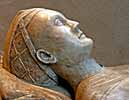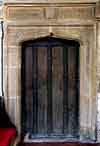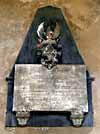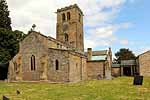For this church:    |
|
Key to Monuments |
North Transept
1. A worn cross slab set upright against the internal face of the west wall perhaps of the late 12th or earlier 13th century (see the Archaeology section for further information).
A worn cross slab set upright against the internal face of the west wall perhaps of the late 12th or earlier 13th century (see the Archaeology section for further information).
2. A badly damaged cross slab (see the Archaeology section for further information). Godfrey, writing in the early 1900s, described it 'having a fleurated cross with a shield of arms on either side. The dexter shield is entirely defaced, but on the sinister shield two small vessels with handles and feet are plainly seen. Of the marginal inscription only the word "Isabelle" is legible.' It is likely to be a memorial to Isabelle, the daughter of George Monboucher and wife of Sir John Clifton who fell at the battle of Shrewsbury in defence of King Henry IV in 1403.
A badly damaged cross slab (see the Archaeology section for further information). Godfrey, writing in the early 1900s, described it 'having a fleurated cross with a shield of arms on either side. The dexter shield is entirely defaced, but on the sinister shield two small vessels with handles and feet are plainly seen. Of the marginal inscription only the word "Isabelle" is legible.' It is likely to be a memorial to Isabelle, the daughter of George Monboucher and wife of Sir John Clifton who fell at the battle of Shrewsbury in defence of King Henry IV in 1403.
3. To the north is a much worn incised slab bearing the figure of a woman. This slab probably commemorates Isabella who was the daughter of Sir Robert Francis and wife of Sir Gervase Clifton, who died in 1457. According to Thoroton the inscription read:
To the north is a much worn incised slab bearing the figure of a woman. This slab probably commemorates Isabella who was the daughter of Sir Robert Francis and wife of Sir Gervase Clifton, who died in 1457. According to Thoroton the inscription read:
Hic jacet Isabella filia Roberti Fraunceis uxor Gervasii Clifton, militis, filii Domini Johannis Clyfton, militis, quae obiit 13 Junii 1457 |
4.Another badly damaged floor slab, near the east wall of the transept, shows the figure of a woman. It is probably dedicated to the memory of Lady Alice Clifton, sister of William Booth, Archbishop of York from 1452-1464. She was the wife of Sir Robert Clifton and died in 1470. Thoroton records the inscription as reading:
Hic jacet Domina Alicia Clifton, filia Johannis Bothe, Ar. Soror bonae memorie Domini Willielmi Bothe, Ebor. Archiepiscopi, & uxor Domini Roberti Clifton, militis, quae obiit 9 Sept. 1470 |
5.Close to this slab are two brasses in memory of Lady Alice's husband Robert, who died in 1478, and their eldest son, Sir Gervase who died in 1491.
Both of these brasses bear inscriptions in Latin, bidding the observer to pray for their souls and refer to the founding of the college of chaplains that both father and son participated.
The inscription relating to Sir Gervase reads:
| Orate pro aia Gervasii Clyfton militis filii et heredis Robti Clyfton militis ffundator collegii de Clyfton finiti et stabilit p doni Gervasiu qui obiit in domo fratrum p’dicator apud london duodecimi die mese maii Ao. dni M°CCCC lxxxxi cui corpus abinde p Agnetam filiain Rob’ti Constable de fflamburgh militis secunde uxor ejusdem Gervasii et alios ejus executores juxta voluntatem suam istut honorifice et decent conductu fuit et sub hoc lapide marmoreo hic humatu cuius anime ppiciet deus pro cuius quidem Agnetis pspitate dum vixit et p’ejus anima cum ab hac luce migravit Speciales ordinantur memorie et oraciones per Gardianum et Capellanos collegii pdci juxta composicoem et statuta inde ordinat ppetuis futuris temporibus devote fiende |
 |
 |
6.The brass commemorating Sir Robert bears a short inscription and represents a knight in full armour with a greyhound at his feet:
| Orate pro anima Roberti Clyfton militis fundator triu capplor collegii in hac ecclia qui obiit nono die mensis Aprilis anno domini millimo CCCClxxviii cuius anime propiciet de ame. |
 |
 |
7.Along the north wall of the transept are two fine alabaster tomb chests. The tomb on the east side is to the memory of Alice, daughter of Thomas Nevill of Rolleston, and the first wife of Sir Gervase Clifton. There is no inscription but the arms on the side of the tomb are of Clifton and Nevill, and Clifton impaling Nevill, 'making the identification certain,' according to Cox.
 |
 |
 |
 |
8.To the west of Alice's effigy lies a beautifully finished recumbent alabaster effigy of 'a knight in armour, at his feet is a crouching lion, beneath his head a peacock, on his surcoat a lion rampant and upon his helmet the Clifton crest.' Cox suggest this late 14th century effigy may represent either Sir Gervase Clifton (d.1391) or Sir John Clifton who was killed at the battle of Shrewsbury in 1403.
 |
 |
 |
 |
9.To the south of these effigies is a large tomb chest, bearing the recumbent effigy of Sir Gervase Clifton (1518-1588/89) with his two wives, Mary and Winifred, on either side.
 |
 |
 |
 |
 |
The tomb has the following inscription around its upper edge:
| Here lyeth the bodies of Sr gervies clifton of clifton in the County of nott knight of dame mary his first wife daughter of Sr John nevell of Cheete in the County of yorke knight & of dame winifryde his second wife the daughter and heire of willm thwaites of oulton in the County of Suffolke esquire wth dame mary deceased [...] of April [anno] domine 1564 the sayd Sr gervies deceased the xxth of January 1587 and the Sayd dame Winifreyde deceased the [...] of [...] anno domini 1[...] whose soules we hope rest in god our Saviour. |
On one side of this tomb are depicted the figures of three sons, Gervase, Robert and Anthony who died in childhood and two daughters, Elizabeth and Frances. On the other side of the monument are four shields commemorating the Clifton family, the Thwaites and the Seagrave families.
10.Beneath the monument to Sir Gervase, on the north side, is a small brass dedicated to George, the only son of Sir Gervase the Gentle. He died in 1587 at the age of 20, but six years before had married Winifred, daughter of Sir Anthony and Lady Anne Thorold. Winifred, three months after his death, bore a son, yet another Gervase. The inscription reads:
Here lyeth George Clifton Esquire who was sonne & heire apparent of Sr |
 |
 |
 |
11.On a floor slab is the following inscription:

THIS STONE COVERETH THE BODY OF DAME ANNE THOROLD |
12.Against the west wall is a large monument to the memory of the first three wives of Sir Gervase Clifton (1587-1666), the first Baronet. The wives were Penelope (d.1613), Frances (d.1627) and Mary (d.1630).
Godfrey comments that ‘This hideous structure was originally placed against the south wall of the chancel, between the east end and the door opening into the Clifton vault, and has been recently (around 1887) removed to its present position. The arms appear to have been re-painted, and differ from those shown in Thoroton’s engraving of the tomb.’ Beneath the sarcophagus is a well carved representation in marble of a grating containing six skulls and some broken bones.
 |
 |
 |
 |
The inscription on the monument is in Latin and reads:
MEMORIAE CONSERVANDAE CAVSA |
13.A partly defaced floor stone, dedicated to Sarah, wife of Robert Clifton, who died November 1703.
| HERE lies the Body of Mrs. CATHERINE MOISES who died Septr ye 29th, in the Year of our Lord 1757 |
15.On the east wall of the transept is a slate tablet to Lieutenant-Colonel Percy Clifton (d.1944) and his wife:
18.George Wells, who was a family friend of the Clifton family and founder of the almshouses for the benefit of the poor, unmarried women in the parish of Clifton in 1709. He died in 1712. The inscription reads:

Toth Clifton Family a friend  Plants and all Creatures from ye silly fly : |
19.A damaged tablet to Thomas Baseldine who died in 1693:
Neare |
20.Also fixed to the east wall is a slate grave marker to Richard Attenbrow and members of his family:

BLESSED ARE Ye DEAD wch die in ye Lord  Afflictions Sore long time I bore  GEORGE SON OF RICH: ATTENBROW  JOSHUA SON OF RICH: ATTENBROW BY |
21.A wooden cross commemorating Able Seaman Cecil Reckless been fixed to the north wall. The inscription reads:
Chancel
22.On the west wall of the chancel is a small brass plate dedicated to a former rector of Clifton, Robert Thirlby, who died in October 1675:
23.There are three tablets on the north wall of the chancel. The westernmost tablet remembers Mary Parry, who died 9 November 1850 aged 81:

SACRED  HER REMAINS ARE INTERRED NEAR THIS SPOT.  THIS MONUMENT IS ERECTED AS AN EARNEST TRIBUTE OF |
24.A further tablet is dedicated to the memory of Henry Parry Denniss Esq., Lieutenant in the 43rd Regiment of the Light Infantry. He died at Hastings on 11 June 1849 aged 26;

SACRED  THIS SIMPLE TABLET IS ERECTED IN TESTIMONY OF THE FERVENT LOVE, UNAVAILING SORROW AND EARNEST HOPE, |
25.The easternmost tablet is dedicated to Sir Robert Clifton who died 28 April 1837 aged 71:

In the family Vault |
26.A small brass plate at the back of the sedilia on the south wall commemorates Dame Arabella Wheeler, daughter of Sir Clifford Clifton and Widow of Sir Francis Wheeler. The inscription reads:
27.There are several more tablets fixed on to the south wall of the chancel, the principal of which is a mural monument to the first Baronet, known as Sir Gervase the Gentle (d.1666), and is fixed over the doorway leading to the Clifton family vault.
 |
 |
 |
 |
The inscription is in Latin and reads:
Hic intus cum patribus & uxoribus suis dormit generosissimus Doms GERVASIUS CLIFTON |
28.A stone monument to the memory of Frances Egerton, daughter of the late Sir Gervase Clifton, who died 5 December, 1866 aged 74:
29.Directly below the Egerton monument is a brass plaque to Henry Robert Clifton (died 1896):

+ To the Glory of God and in dear Memory of Henry Robert Clifton |
30.An oval tablet to the memory of the Rev. Henry Spencer Markham, Rector of Clifton, who died in 1844 aged 39:
31.On the west wall of the chancel is a small marble tablet to Gervase Holland who died August 1673. The Latin inscription reads:
33.In the floor of the choir is a slab to the memory of the Rev. William Standfast, Doctor of Law who died 4 June 1765. Standfast is best remembered for his donation of 'his whole study of books to lay the foundation of a Public Library for the use of persons of liberal education residing in the town and its immediate neighbourhood.' This collection is in Bromley House Subscription Library, Nottingham. The inscription reads:
 Door to family Door to familyvault |
The vault, accessed by a doorway in the south wall dated 1632, contains approximately twenty five coffins, all of which hold the mortal remains of the several generations of the Clifton Knights and their wives. There is a small lead coffin believed to contain the heart of Sir William Clifton who was involved in the Crusades. Also, Throsby in 1790 refers to a very ancient lead coffin shaped to receive the head and shoulders of its inhabitant. It is quite possible that this is the coffin of Sir Gervase Clifton who was beheaded after the Battle of Tewksbury, in 1471, by order of King Richard III.
South Transept
 Floor slab Floor slab |
 Initials on the Initials on the porch wall |
A floor slab in the south transept commemorates a black servant, Joseph, commonly known as 'The Black Prince':
HERE LIETH INTERRED THE |
On the right side of the opening into the porch, at a height of six feet four inches from the ground, is a mark and the letters 'I– P' that represent the height of this man, also known as 'The Indian Prince'.
South Aisle
There are several tablets at the eastern end of the south wall of the south aisle.
38. Sir Gervase, the sixth Baronet, is buried in a brick grave having been unwilling to be buried in the family vault, humbly estimating himself unworthy of such an honour. There is a fine marble monument on the south wall of the south aisle surmounted by his arms and crest and which records the following: The creation of the Baronetcy (the third among those created) by King James I; as well as the fact that Sir Gervase wished to be buried where he now lies … the birth of his seven children (including Sir Robert, Sir Juckes and Sir Arthur) and the date of his death in 1815. The inscription is in Latin and reads:
Sir Gervase, the sixth Baronet, is buried in a brick grave having been unwilling to be buried in the family vault, humbly estimating himself unworthy of such an honour. There is a fine marble monument on the south wall of the south aisle surmounted by his arms and crest and which records the following: The creation of the Baronetcy (the third among those created) by King James I; as well as the fact that Sir Gervase wished to be buried where he now lies … the birth of his seven children (including Sir Robert, Sir Juckes and Sir Arthur) and the date of his death in 1815. The inscription is in Latin and reads:
AB HOC HAVB PROCVL MARMORE |
39.There is also a floor slab dedicated to Catherine, the wife of John Townsend, born 4 January 1775 and died 1 May 1818; Gilbert Townsend, their son, and John Townsend who died 20 July 1840.






















